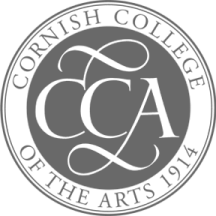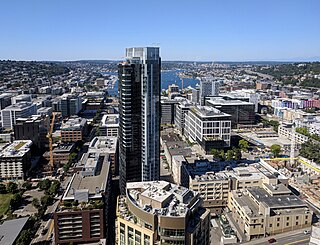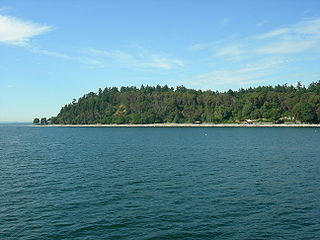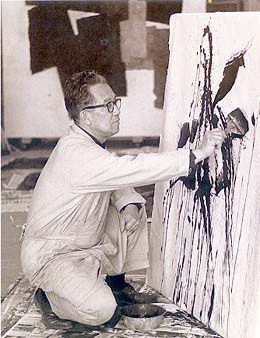
The Century 21 Exposition was a world's fair held April 21, 1962, to October 21, 1962, in Seattle, Washington, United States. Nearly 10 million people attended the fair during its six-month run.

The Seattle International Film Festival (SIFF) is a film festival held annually in Seattle, Washington, United States since 1976. It usually takes place in late May and/or early June. It is one of the largest festivals in the world, and features a diverse assortment of predominantly independent and foreign films, and a strong contingent of documentaries.

Cornish College of the Arts (CCA) is a private art college in Seattle, Washington. It was founded in 1914.

The Space Needle is an observation tower in Seattle, Washington, United States. Considered to be an icon of the city, it has been designated a Seattle landmark. Located in the Lower Queen Anne neighborhood, it was built in the Seattle Center for the 1962 World's Fair, which drew over 2.3 million visitors.

Seattle Center is an entertainment, education, tourism and performing arts center located in the Lower Queen Anne neighborhood of Seattle, Washington, United States. Constructed for the 1962 World's Fair, Seattle Center's landmark feature is the 605 ft (184 m) Space Needle, an official city landmark and globally recognized symbol of Seattle's skyline. Other notable attractions include the Pacific Science Center, Climate Pledge Arena, and the Museum of Pop Culture (MoPOP), as well as McCaw Hall, which hosts both the Seattle Opera and Pacific Northwest Ballet. The Seattle Center Monorail provides regular public transit service between Seattle Center and Westlake Center in Downtown Seattle, and is itself considered a tourist attraction.

The Seattle Center Monorail is an elevated straddle-beam monorail line in Seattle, Washington, United States. The 0.9-mile (1.4 km) monorail runs along 5th Avenue between Seattle Center and Westlake Center in Downtown Seattle, making no intermediate stops. The monorail is a major tourist attraction but also operates as a regular public transit service with trains every ten minutes running for up to 16 hours per day. It was constructed in eight months at a cost of $4.2 million for the 1962 Century 21 Exposition, a world's fair hosted at Seattle Center. The monorail underwent major renovations in 1988 after the southern terminal was moved from its location over Pine Street to inside the Westlake Center shopping mall.

Queen Anne is a neighborhood in northwestern Seattle, Washington. Queen Anne covers an area of 7.3 square kilometers (2.8 sq mi), and has a population of about 28,000. It is bordered by Belltown to the south, Lake Union to the east, the Lake Washington Ship Canal to the north and Interbay to the west.

The Seattle Japanese Garden is a 3.5-acre (1.4 ha) Japanese garden in the Madison Park neighborhood of Seattle. The garden is located in the southern end of the Washington Park Arboretum on Lake Washington Boulevard East. The garden is one of the oldest Japanese gardens in North America, and is regarded as one of the most authentic Japanese gardens in the United States.

Seattle is a significant center for the painting, sculpture, textile and studio glass, alternative, urban art, lowbrow and performing arts. The century-old Seattle Symphony Orchestra is among the world's most recorded orchestras. The Seattle Opera and Pacific Northwest Ballet, are comparably distinguished. On at least two occasions, Seattle's local popular music scene has burst into the national and even international consciousness, first with a major contribution to garage rock in the mid-1960s, and later as the home of grunge rock in the early 1990s. The city has about twenty live theater venues, and Pioneer Square is one of the country's most prominent art gallery districts.

South Lake Union is a neighborhood in central Seattle, Washington, so named because it is at the southern tip of Lake Union.

Lincoln Park is a 135 acres (0.55 km2) park in West Seattle alongside Puget Sound. The park's attractions include forest trails, a paved walkway along the beach, athletic fields, picnic shelters, and a heated saltwater swimming pool which is open during the summer. The park is adjacent to the Fauntleroy neighborhood.

Westlake Park is a 0.1-acre (400 m2) public plaza in Downtown Seattle, Washington, United States. It was designed by Robert Mitchell Hanna.
Dudley Christopher Carter was an artist and woodcarver from the Pacific Northwest. His works are on display in the U.S. states of Washington, Oregon and California. There are also works of his on display in Japan and Germany, as well as a private collection in Israel
Allied Arts of Seattle is a non-profit organization in Seattle, Washington, USA. The organization advocates for public funding of the arts, better urban planning and architecture, and other civic improvements. The organization claims to be the "oldest non-profit organization in Seattle dedicated to urban livability", but, in any case, at 50+ years old is certainly a venerable organization by the standards of a city barely older than 150 years It was a major force in establishing the Seattle Arts Commission, creating Seattle Center on the grounds of the Century 21 Exposition and preserving historical landmarks and neighborhoods, particularly Pioneer Square and Pike Place Market, as well as defeating the 2012 Seattle Olympic bid.

Paul Chikamasa Horiuchi was an American painter and collagist. He was born in Yamanashi, Japan, and studied art from an early age. After immigrating to the United States in his early teens, he spent many years as a railroad worker in the Western U.S. In 1946, he moved to Seattle, Washington, where he eventually switched his focus from painting to collage and came to be associated with the "Northwest School" of artists. In his mid-forties, he was finally able to devote himself to art full-time, his unusual collage style becoming very popular in the 1950s and 60s. He continued creating art at his studio in Seattle until succumbing to Alzheimer's-related health problems in 1999.

Washington Hall is a historic building and a registered city landmark in Seattle, Washington, that is listed on the National Register of Historic Places. It was originally built as a community center by the Danish Brotherhood in America, a fraternal organization, with meeting halls and one-room apartments for new immigrants. In 1973, the building was sold to the Sons of Haiti who leased the space to various tenants. It was purchased in 2009 by Historic Seattle and was renovated and re-opened in 2010 as an events and performance space.

The architecture of Seattle, Washington, the largest city in the Pacific Northwest region of the U.S., features elements that predate the arrival of the area's first settlers of European ancestry in the mid-19th century, and has reflected and influenced numerous architectural styles over time. As of the early 21st century, a major construction boom continues to redefine the city's downtown area as well as neighborhoods such as Capitol Hill, Ballard and, perhaps most dramatically, South Lake Union.

The International Fountain, designed by Tokyo-based architects Kazuyuki Matsushita and Hideki Shimizu during 1961–1962 for the Century 21 Exposition, is a concrete fountain and sculpture installed in Seattle Center in the U.S. state of Washington.

A statue of Leif Erikson is installed at Seattle's Shilshole Bay Marina, in the U.S. state of Washington. The 16-foot tall sculpture was donated by the Leif Erikson League for the Century 21 Exposition. It was relocated to Shilshole Marina in 2007. According to Lonely Planet, the statue is surrounded by a stone circle and serves as "an important reminder of Seattle's Nordic heritage".

Kreielsheimer Promenade is a 17,800-square-foot public plaza in the Seattle Center, in the U.S. state of Washington. The plaza is an entry to McCaw Hall and a pedestrian corridor connecting the campus and Mercer Street.



















